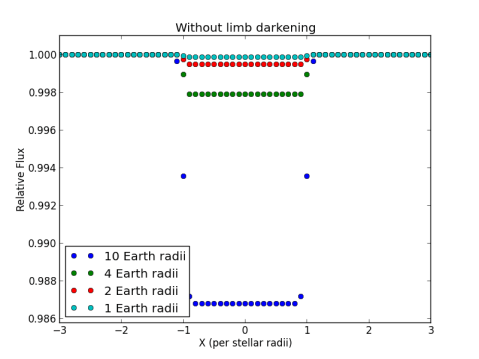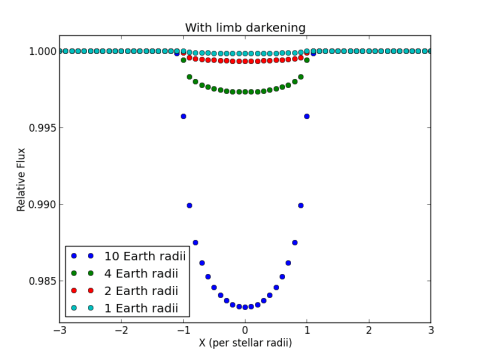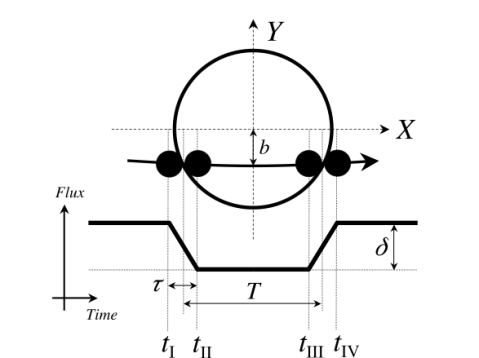What factors impact transit shape
I’m rewriting the simulation code I use for making simulated transits and injecting them into Kepler light curves from a program language called IDL to python. I’m working on a new paper idea and project with Planet Hunters so I thought now would be the perfect to time to make the coding switch. The actual part of the code that computers the shape of the transit comes from publicly available code written by another astronomer, Ian Crossfield (if you want to play with the code you can find it here).
I’ve been doing some simple tests to make sure the code works and thought that it would be worth using the test output as a great way to talk about a few things that affect the transits that you see in the Kepler light curves on the Planet Hunters website.
Ratio of the size of the planet to the size of the star:
The transit depth is the ratio of the surface area of the star’s disk blocked out by the planet’s disk. So the transit depth is the square of the planet radius divided by the star’s radius. The majority of Kepler stars are similar in size to the Sun or a bit bigger or smaller, so in general the bigger the planet the bigger the transit you see.
Below is the ideal transits you’d see for a series of planet radii assuming the star was perfectly quiet and is uniformly bright. For the plot below I assume the star 0.8 times the radius of the Sun and the planets cross the center of the star.  These transits are very boxy – In real life they won’t look like this at least not on the ingress and egress (the edges of the transit). That’s because the a star is not a uniformly illuminated disk. It is darker at the edges than it is at the center. We call this limb darkening. What is happening is that you are seeing into different layers of the Sun depending on how far from the center of the disk. So the center is hotter layers and therefore brighter than the edges. You can see the effect when looking at the Sun shown below during the transit of Venus.
These transits are very boxy – In real life they won’t look like this at least not on the ingress and egress (the edges of the transit). That’s because the a star is not a uniformly illuminated disk. It is darker at the edges than it is at the center. We call this limb darkening. What is happening is that you are seeing into different layers of the Sun depending on how far from the center of the disk. So the center is hotter layers and therefore brighter than the edges. You can see the effect when looking at the Sun shown below during the transit of Venus.

Transit of Venus – Image credit- Wikipedia – http://en.wikipedia.org/wiki/File:2012_Transit_of_Venus_from_SF.jpg – You can see the limb darkening is quite apparent. The edges of the sun are darker than the center.
Limb darkening changes mostly the edges of the transit making them softer and rounder less box like. If we account for limb darkening for the same planet transits shown in the previous plot, they now look look this:

Simulated planet transits including limb darkening of the star. For the plot I assume the star 0.8 times the radius of the Sun and the planets cross the center of the star
You can see the transits are more U-shaped like we see in the Planet Hunters interface. Now the plot is very zoomed in, it shows 3x the star’s radius on either side, but if you zoomed in on Planet Hunters this is what you’ll see for a spotted transit if the planet is very large and the transit depth is pretty large compared to the measurement noise of Kepler.
Another factor to account for is the impact parameter. You can think of the planet’s transit across the star in the x- direction and think of the impact parameter as the y project coordinate of the transit. In essence you can think of as the impact parameter (b) as how close in the y direction is planet to the center of the star’s disk.

Transit schematic from Winn 2011 – http://arxiv.org/abs/1001.2010v3
Changing the impact parameter changes the duration of the transit. If we assume no limb darkening and a uniformly illuminated stellar disk this is what you would see:

Larger b higher from the center of the star the planet crosses. Transits of a 10 Earth radii (Jupiter-sized planet) with varying impact parameters and no limb darkening assuming a 0.8 x Solar radius star
Now if we add in limb darkening we get:

Larger b higher from the center of the star the planet crosses. Transits of a 10 Earth radii (Jupiter-sized planet) with varying impact parameters with limb darkening assuming a 0.8 x Solar radius star
You can see for the highest impact parameter (where the planet is crossing very close to the edge of the star) the transit looks pretty V-shaped like an eclipsing binary eclipse when we account for limb darkening. This is why if you see a V-shaped transit we typically think it’s most likely not a planet transit because the vast majority of times the planet transits will be U-shaped with a flatish bottom. You also see the depths on the bottom change slightly. This is because they are not all crossing the very center of the star which is the brightest point anymore.
One other factor that will effect the shape will be the duration of the transit which depends on the orbital period of the planet and the eccentricity of the orbit, but for all of these plots I’m plotting in the X-axis in terms of the size of the star.
6 responses to “What factors impact transit shape”
Trackbacks / Pingbacks
- - February 2, 2013
- - February 11, 2013

Meg,
This is an excellent article! Thanks.
Indeed, a great article!
Question: is limb darkening always the same, for every (Sun-like) star, in every waveband (filter)? “Same” as in the same shape (analytic form) and same parameter values (constants, in the analytic form). If not, how do you control for this, when you model candidate transits?
Question: In the image of Venus transiting the Sun, there are sunspots. How common are sunspots on the Sun-like stars in the Kepler field? How do sunspots change the transit light curve? How are sunspots modeled?
What equations did you use to model the transit curves?
I wonder if you could provide the raw data which you used to create your graphs? I am a physics teacher at Wallace High School and wold love to get my students to create their own graphs from your data.